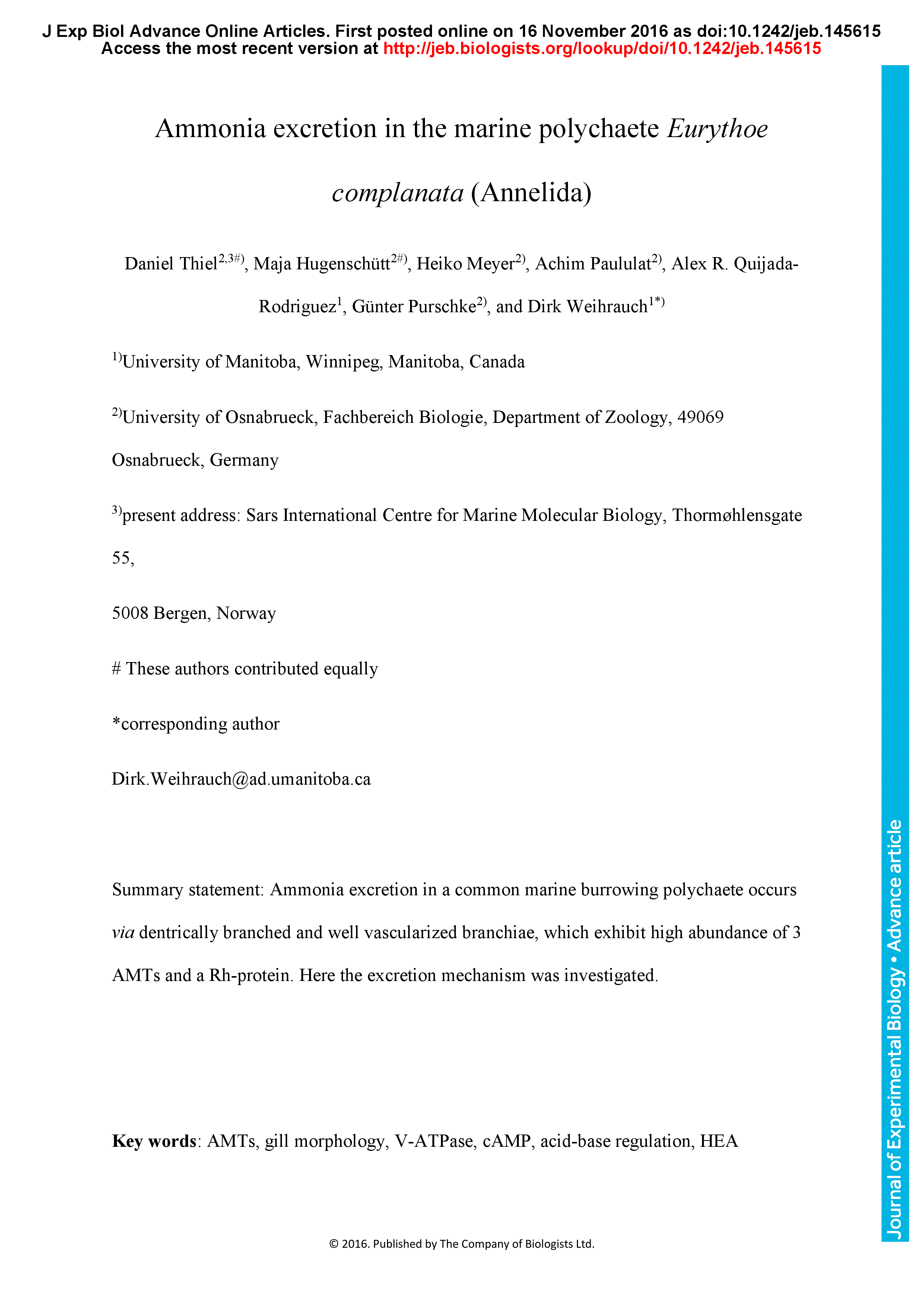Ammonia is a toxic waste product from protein metabolism and needs to be either converted into less toxic molecules or, in the case of fish and aquatic invertebrates, excreted directly as is. In contrast to fish, very little is known regarding the ammonia excretion mechanism and the participating excretory organs in marine invertebrates. In the current study ammonia excretion in the marine burrowing polychaete Eurythoe complanata was investigated. As a potential site for excretion the 100-200 micrometer long, 30-50 micrometer wide and up to 25 micrometer thick dentrically branched, well ventilated and vascularized branchiae (gills) were identified. In comparison to the main body, the branchiae showed considerably higher mRNA expression levels of Na+/K+-ATPase, V-type H+-ATPase, cytoplasmatic carbonic anhydrase (CA-2), a Rhesus-like protein, and three different AMTs. Experiments on the intact organism revealed that ammonia excretion did not occur via apical ammonia trapping, but was regulated by a basolateral localized V-type H+-ATPase, carbonic anhydrase and intracellular cAMP levels. Interestingly, the V-type H+-ATPase seems to play a role in ammonia retention. A one week exposure to 1 mmol l−1 NH4Cl (HEA) did not cause a change in ammonia excretion rates, while, the 3 branchial expressed AMTs were in tendency down-regulated. This indicates a shift of function in the branchial ammonia excretion processes under these conditions.
Ammonia excretion in the marine polychaete Eurythoe complanata (Annelida)
These authors contributed equally
Currently Viewing Accepted Manuscript - Newer Version Available
- Split-screen
- Views Icon Views
- Open the PDF for in another window
-
Article Versions Icon
Versions
- Version of Record 01 February 2017
- Accepted Manuscript 01 January 2016
- Share Icon Share
-
Tools Icon
Tools
- Search Site
Daniel Thiel, Maja Hugenschütt, Heiko Meyer, Achim Paululat, Alex R. Quijada-Rodriguez, Günter Purschke, Dirk Weihrauch; Ammonia excretion in the marine polychaete Eurythoe complanata (Annelida). J Exp Biol 2016; jeb.145615. doi: https://doi.org/10.1242/jeb.145615
Download citation file:
Advertisement
2023 JEB Outstanding Paper Prize shortlist and winner

The JEB Editors are delighted to announce the shortlisted authors for the 2023 JEB Outstanding Paper Prize. Read the winning paper - Tiny spies: mosquito antennae are sensitive sensors for eavesdropping on frog calls - by Hoover Pantoja-Sanchez and Brian Leavell from Ximena Bernal's lab at Purdue University, USA.
JEB Science Communication Workshop for ECRs

If you’re an early-career researcher interested in science communication and are attending the SEB Annual Conference in Prague this summer, come a day early and join the JEB Editors at a sci comm workshop to learn the key writing skills needed to promote your research to a broad audience beyond your peers (1 July at 14.30-17.30). Places are limited to 24 attendees, and applicants should apply through the SEB registration page by 30 April 2024.
Bridging the gap between controlled conditions and natural habitats in understanding behaviour

Novel technologies enable behavioural experiments with non-model species, in naturalistic habitats and with underexplored behaviours. In their Commentary, Scholz and colleagues discuss how to obtain a deeper understanding of the natural ecology and lifestyle of study animals.
Beluga metabolic measures could help save species

To help save animals from extinction, it’s important to understand what each species needs to survive. This led Jason John et al. to measure the metabolic rates of captive belugas to develop a ‘fish calculator’ showing that the whales need to eat ~23 salmon per day.
ECR Workshop on Positive Peer Review

Are you an ECR looking for tips on how to write concise, astute and useful manuscript reviews? If so, join the JEB Editors at a 2-hour JEB-sponsored Workshop on Positive Peer Review at the Canadian Society of Zoologists annual meeting in Moncton on 9 May 2024 at 13.00-15.00. There are 25 spaces for ECRs and selection is first come, first serve. To sign up, check the ECR Workshop box when you register for the CSZ meeting.



